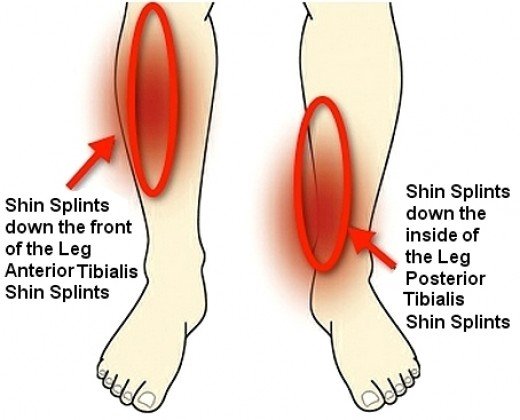A Footballer’s Guide To Shin Splints & Tibial Pain
I have officially been a medical and strength-and-conditioning professional long enough to see patterns emerge from amongst my players, one of the most classic being: a break from high-intensity training (whether due to injury, illness, or off-season) and a restart of training, resulting in stinging shin pain that escalates under load and decreases at rest.
This type of pain is peculiar; it unspecific at best, making it difficult to diagnose and extending the time it takes to recover from. With a little patience, strategic strength training, and a good bit of load monitoring however, “shin splint” and medial tibial pain tend to evaporate.
—————
Liam* entered my office for the fourth time in two months with the same complaint; sharp pain on the inside of his shinbone that feels like being stabbed by a knife while playing football but lets up about an hour after training. “Sometimes I feel it the day after a game, though, and going up the steps feels like torture.”
He had been injured and suffered with COVID multiple times in the last year, leading to long breaks with little-to-no training intensity. His pre-season had been nothing but six weeks of going 0-100mph in an under-fueled, undertrained Toyota Camry that was expected to race like a Porsche on Day One.
It is rarely my first instinct to declare a full pause in activities for a client or athlete, but I felt it was necessary. Until now, without a training ban, I had been unsuccessful in convincing Liam not to train 3x a week on the pitch. Between him and his head coach, even though he was in pain every second, the decision was that he was going to train and play.
“Full break for one week,” I said. “I want to see you in the gym twice for lifting, you can bike and walk at your leisure, but no running, football, or anything that induces pain right now.”
He was understandably furious. Fighting through pain is something ambitious or high-performance athletes accept as a part of life. Some even expect and welcome it.
But, in what was clearly a case of medial tibial stress syndrome (MTSS or Shin Splints), the best option forward was to pull back the training load, let the inflammation do its job and recede, and start adding in intensity slowly, as Liam could adapt to it.
At first, he continued training normally and the pain did nothing except get worse until it was unbearable. After six weeks rehab and careful monitoring, though, we was back on the pitch pain-free and monitoring his own load and pain.
*Athlete name changed for data/privacy protection.
—————
MTSS graphic taken from this site.
This example is a classic case of MTSS that flares up with high-intensity training that is poorly managed, then hangs around, causing lower leg pain and a large mental toll to the athlete until it is discovered and dealt with. By far the most common cause for shin pain, in my experience, is spiking training intensity too quickly and not allowing the tissues of the lower leg to adapt to this demand.
Of course, this is not the only time shin pain will pop up. MTSS is a multi-dimensional injury with several potential contributing factors, such as poor-fitting shoes, a notably increased bodyweight, zero foot/calf/ankle strength and movement, or other weaknesses in the lower body and trunk.
However, the key pattern to watch out for is an extended period away from high-intensity, sport-specific training and a sudden restart at a level and load that the athletes’ lower leg cannot withstand.
(It is, of course, important to note that there are other lower-leg syndromes and injuries that must be determined from MTSS, such as compartment syndrome or infections. At best, see an orthopedist to get cleared for those issues before starting shin splint rehab - it is important to be sure it is not a stress fracture or infection!)
Experiences & Considerations For Rehabilitation:
How much time off?
Hitting the pause button is a critical part of the first week of MTSS rehab, as it is at its core an overtraining syndrome, but how long this break should be is player-specific. It is most likely that they want to get back to training and playing as soon as possible, leaving them reluctant to take more than a few days’ break. I usually plan for 2 days off, enough to get pain and inflammation to reduce before starting an active rehabilitation phase with the end goal of returning to play as quickly and healthfully as possible.
Pain is our measuring stick; at first, we pull back load completely and work out way up to the pain threshold. As soon as the pain starts kicking up, we start pulling back.
Example: if the player has zero pain on a mile-long jog but feels pain after 3 steps of a sprint, we know that 100% intensity and speed is too much. The athlete can jog and bike to their hearts’ content, as long as they have no pain. This allows for activity that is conducive to their sport (aerobic endurance, even speed work on a bike) while gradually increasing duration and intensity, allowing the tissues of the lower leg to recover and gain resilience over time.
What should we do in the gym?
As mentioned above, one contributor to MTSS may be weakness throughout the body, specifically the feet, legs, and trunk. Adding in 3-4 lifts a week until the athlete can return to a respectable training intensity in their sport is recommended, then reducing down to 2-3x weekly for maintenance, in a best-case scenario.
There are more than enough ways to increase intensity in the gym without overtaxing the shins and ankles. Squats, deadlifts, lunges, split squats, throws, presses, pulls, and slams are all part of our itinerary in the gym, gradually adding intensity here too. Tempo work, such as eccentric hamstring, squat, or bench work can help prepare a player for play without having to step a foot on the pitch.
I strongly recommend barefoot training where possible in the early stages of MTSS rehab, starting with an extensive warmup that includes Tibialis Raises, Calf Raises, Floating Heel Iso Holds to desensitize tissues, followed by heel and toe walking to build strength in different positions - especially if the athlete cannot run without pain at all.
How can we increase load and intensity?
Again, with starting in the gym, we can manage load increases with great attention: duration, frequency, volume, and intensity of training can all be carefully managed with minimal uncontrolled factors inside the gym, unlike on the pitch (contact vs. non-contact, distance, and speed, for example, can be hard to regulate in sport-specific training).
As long as the athlete is complaint-free, one of the load markers can be increased per training session - within reason. Just because an athlete does not report pain or irritation during the training session, however, does not give us free rain to crank up the intensity and volume of the next session; it is important that:
The athlete remains complaint-free and pain-free even after training (and the next day).
We allow the body time to adapt and recover between sessions. Otherwise we risk more harm than good.
Even athlete is going to have different sets of needs at this point in rehabilitation. This is the chance to improve strength, power, or even implement strength-endurance, depending on the demands of sport and the player’s fitness level. Upper body training should be a given here.
Once the basics, such as squats, lunges, deadlifts, step-ups, and calf raises are no longer irritating, it’s time to start the low-intensity plyometrics (smaller jumps and throws), gradually increasing intensity and then volume. Add in jogging on turf/grass or another soft surface (if not pain-free already), gradually increasing intensity/speed and then duration.
NOTE: Do not overdo the running or start too quickly! The repeated pounding of asphalt is the quickest way to invite shin splint pain right back in the door, so be sure to add in running slowly (I start with barefoot on grass and work from there) and wait to see if complaints pop up in the days/sessions after.
Once running at normal pace has proved to be no issue and high-intensity jumps (verticals, broad jumps, single-leg jumps) are checked off the list, sprinting on soft surfaces with increasing speed (aka NOT starting at 100%) and distance are next on the list.
Each of these movements should be microdosed into the plan, tested for their pain level before being implemented. This is the time to build resilience in the athlete’s whole body, to require the lower leg to adapt to a higher load - but not too quickly, or else it will revolt!
Is it really not just an unstable, weak ankle?
Ankles don’t get “weak”. However, because MTSS is multifactorial, it could be related to a weak foot or a poor shoe. By training strength and movement barefoot, we begin training the intricacies and arches of the foot and, by default, ankle stability. By all means, work to improve any limited hip and ankle mobility during this time, but avoid putting all your MTSS eggs in the “my ankles are just shitty” basket!
Can I not just train through it?
You could, and it might work. Depending on your fitness level and training load, the pain could dissipate as your tendons get more durable through continued training. However, you will suffer in the meantime and pushing through is, in this case, not a promise for improvement. It might just make your life miserable until you, sooner or later, pull back training load and build back up.
Some further papers worth reading on MTSS & Co.:
Mattock, J., Steele, J. R., & Mickle, K. J. (2018). A protocol to prospectively assess risk factors for medial tibial stress syndrome in distance runners. BMC sports science, medicine & rehabilitation, 10, 20. https://doi.org/10.1186/s13102-018-0109-1
Veugelers, K., Young, W., Fahrner, B., & Harvey, J. (2015). Different methods of training load quantification and their relationship to injury and illness in elite Australian football. Journal of Science and Medicine in Sport. 19. 10.1016/j.jsams.2015.01.001.

